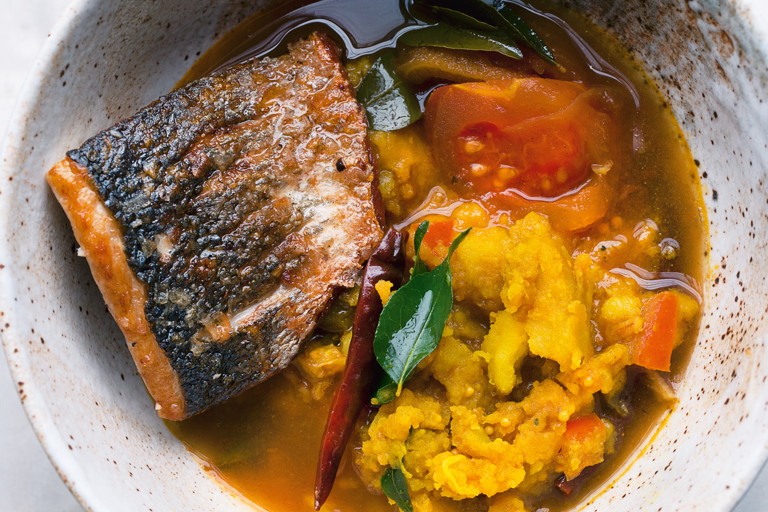Sea bass and turmeric potatoes in rasam broth
Item 1 of 1
- medium
- 6
- 1 hour 10 minutes
A mixture between a hearty fish soup and a fish dish served with a sauce, this sea bass fillet recipe from Yotam Ottolenghi and Ramael Scully is inspired by the flavours of South Indian cuisine and packed-full of the sweet-sour notes of tamarind.
First published in 2015
Extracted from NOPI: The Cookbook by Yotam Ottolenghi and Ramael Scully. (Ebury Press, £28)
Photography by Jonathan Lovekin
Ingredients
Metric
Imperial
Sea bass
- 6 sea bass fillets, 840g, skin lightly scored
- 30g of ghee
- 1 tbsp of lemon juice
- 10g of coriander leaves, optional
- coarse sea salt to taste
- black pepper to taste
Potatoes
- 620g of Désirée potatoes, or a firm, waxy variety, peeled and cut into 2 1/2 cm cubes
- 15g of ghee
- 8 curry leaves, fresh and just the stems, 20g
- 1 1/2 tbsp of yellow mustard seeds
- 1 medium onion, finely diced, 100g
- 4 garlic cloves, finely diced
- 1 tsp ground turmeric
- 2 tomatoes, halved, seeds removed and roughly chopped, 100g
- 10g of unsalted butter
Rasam
- 100g of tamarind pulp
- 1 tbsp of sunflower oil
- 2 medium onions, thinly sliced, 200g
- 8 garlic cloves, crushed
- 1 1/2 tbsp of garam masala
- 12 curry leaves, fresh and just the stems, 25g
- 2 dried chillies, large
- 3 tomatoes, 300g, each cut into 6 wedges, 2cm wide
SAVE RECIPE
Method
1
Place the potatoes in a medium saucepan and cover
with salted water. Bring to the boil, then reduce the
heat to medium and simmer for 10 minutes, until just
cooked. Drain and set aside
2
Wipe the pan dry and return it to a medium heat with the 15g of ghee. When melted, add the 8 stems of curry leaves and mustard seeds and fry for 2 minutes, until fragrant
3
Add the onion and garlic and fry for another 3 or 4 minutes, until starting to soften. Add the turmeric, tomatoes and cooked potatoes, stir to coat the potatoes with the spices, then cook for a minute or so before adding the butter, 1 teaspoon of salt and a good grind of black pepper. Cook for a final minute, then set aside and just warm up when you need it
4
To make the rasam, pour 900ml of boiling water over the tamarind and set aside for 30 minutes, for the pulp to soften and disintegrate in the water. Use your hands to break up and dissolve the pulp, then
strain through a fine mesh sieve and discard the seeds
5
Put the sunflower oil into a large pot and place on a medium heat. Add the onions and garlic and fry for 4–5 minutes, stirring from time to time, until starting to soften. Add the garam masala, 12 stems of curry leaves and chillies and fry for another minute before adding the tomatoes
6
Pour over the tamarind water, reduce the heat to medium-low and simmer very gently for 15 minutes; take care that it does not come to the boil, as this will cause the tamarind pulp to split. Add 2 teaspoons of salt, stir through and set aside. You can leave this to infuse for a few hours and then, when ready to serve, there are two options
7
For a more formal look, strain the rasam for a clear broth; for a more rustic and informal look, you can skip the straining and keep the onion, garlic, curry leaves and chillies in the pot. Either way, you’ll need to return it to the stove and warm it through before serving
8
To cook the fish, place a large frying pan on a medium heat and add the ghee. Use 1 1/2 teaspoons of salt to sprinkle over the skin side of all 6 fish, along with a grind of black pepper
9
When the ghee has melted, add the fish to the pan, skin-side down: you might need to do this in two batches so as not to overcrowd the pan. Fry for 3–4 minutes, until crisp and golden-brown. Use another 1 1/2 teaspoons of salt to sprinkle on the flesh side of the fish, along with some more black pepper, then flip the fish over and cook for a final minute. Remove from the heat and drizzle with the lemon juice
10
To serve, spoon the warm potatoes into a bowl. Place a fish on top or alongside, skin-side up, and ladle over the rasam. Finish with a sprinkle of coriander, if using, and serve
First published in 2015
Get in touch
Please sign in or register to send a comment to Great British Chefs.


